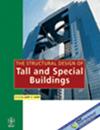Inelastic seismic behavior of asymmetric structures with mass and stiffness eccentricity under bidirectional ground motions
IF 1.3
3区 工程技术
Q3 CONSTRUCTION & BUILDING TECHNOLOGY
引用次数: 1
Abstract
Structures with an asymmetric plan have proved to be severely vulnerable during the past earthquakes. The vulnerability may arise due to the uneven distribution of stiffness or mass. Most of the research focused on studying the eccentricity arising due to the irregular stiffness distribution. On the other hand, the systems with mass eccentricity arising due to the uneven distribution of mass at floor level are given relatively little attention. Hence, the present paper comprehensively studied the stiffness and mass eccentric systems together. In each case, the structure is subjected to bidirectional components of ground motion, which reflects the real situation more closely. So, for the lateral load‐resisting elements (columns), effect of biaxial interaction due to simultaneous bidirectional movement is included in the hysteresis behavior as explained in the paper to make a reasonably accurate prediction. Primarily idealized single‐story systems were used to study how asymmetric structures are vulnerable if they have stiffness or mass eccentricity. Further, the three‐story asymmetric systems were also included in the scope of the study to observe the effect of higher modes. To simulate a more practical situation, the present paper considers higher eccentricity in the first story of the three‐story system due to functional reasons, while the upper stories have lesser eccentricities compared to the first story. The present study shows that mass eccentric systems are equally vulnerable to earthquakes as stiffness eccentric systems. Further, three‐story systems show a manifold increase in response compared to its single‐story counterparts. Such a study may help to develop more insight into the generic behavior of plan asymmetric systems, leading to the improvement of design guidelines.具有质量和刚度偏心的不对称结构在双向地震动下的非弹性地震行为
在过去的地震中,非对称平面结构被证明是非常脆弱的。由于刚度或质量分布不均匀,可能会产生脆弱性。大多数研究都集中在研究由于刚度分布不规则而产生的偏心。另一方面,由于楼面质量分布不均匀而产生质量偏心的系统较少受到关注。因此,本文综合研究了刚度偏心系统和质量偏心系统。在每一种情况下,结构都受到地面运动的双向分量,更能反映真实情况。因此,对于抗侧荷载单元(柱),将双向同时运动的双轴相互作用的影响纳入本文所解释的滞回行为中,以做出合理准确的预测。主要理想化的单层系统被用来研究不对称结构在具有刚度或质量偏心时是如何脆弱的。此外,三层不对称体系也被纳入研究范围,以观察高阶模态的影响。为了模拟更实际的情况,本文考虑由于功能原因,三层体系的第一层偏心较大,而上层的偏心比第一层小。本研究表明,质量偏心体系与刚度偏心体系同样容易受到地震的影响。此外,与单层系统相比,三层系统的响应增加了很多。这样的研究可能有助于深入了解平面非对称系统的一般行为,从而改进设计指南。
本文章由计算机程序翻译,如有差异,请以英文原文为准。
求助全文
约1分钟内获得全文
求助全文
来源期刊
CiteScore
5.30
自引率
4.20%
发文量
83
审稿时长
6-12 weeks
期刊介绍:
The Structural Design of Tall and Special Buildings provides structural engineers and contractors with a detailed written presentation of innovative structural engineering and construction practices for tall and special buildings. It also presents applied research on new materials or analysis methods that can directly benefit structural engineers involved in the design of tall and special buildings. The editor''s policy is to maintain a reasonable balance between papers from design engineers and from research workers so that the Journal will be useful to both groups. The problems in this field and their solutions are international in character and require a knowledge of several traditional disciplines and the Journal will reflect this.
The main subject of the Journal is the structural design and construction of tall and special buildings. The basic definition of a tall building, in the context of the Journal audience, is a structure that is equal to or greater than 50 meters (165 feet) in height, or 14 stories or greater. A special building is one with unique architectural or structural characteristics.
However, manuscripts dealing with chimneys, water towers, silos, cooling towers, and pools will generally not be considered for review. The journal will present papers on new innovative structural systems, materials and methods of analysis.

 求助内容:
求助内容: 应助结果提醒方式:
应助结果提醒方式:


